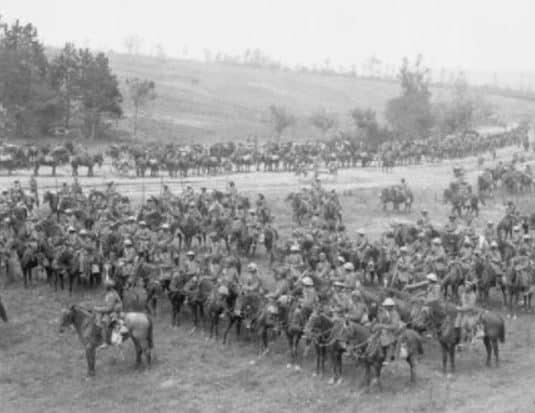Givenchy, 1914
Fought from 18-22 December 1914 the Battle of Givenchy saw an initially advancing British force face strong opposition (and counter-attack) from a solidly entrenched German force around the village of Givenchy (in Pas-de-Calais, which was held by the British). With the French under heavy pressure at Arras, the order was given that the British force would provide relief by attacking the Germans around Givenchy, thus preventing German reinforcement of Arras from that quarter at least.
The Honour is borne on the Guidon of the 8th Hussars.
Detail
The 8th Hussars started the war in the Ambala Brigade, 5th Cavalry Division next to native Indian Mounted Regiments, seeing their first action in December 1914 at Givenchy.
On the 20th and 21st of December the Indian Corps, with the Lahore and Meerut Divisions, offered a stout defence of Givenchy, which ultimately proved successful.
The 8th Hussars received orders on the 20th that it was to support the Indian Corps, but by 10 am it was found that this support was not required. Still, it was to hold itself in readiness to march at an hour’s notice. At 1 pm orders came for the regiment to move and form upon the Route Nationale, facing east towards Bethune.
At 11.30 pm orders were again received to be ready to move at short notice. At 12.45 am on the 21st the regiment was ordered to saddle up ready to move off at 1.15 am The Brigade moved off to Gorre half an hour later, reaching its destination and dismounting at 3 am.
The regiment set out and dismounted at the head of Gorre village. Each hussar had two hundred rounds of ammunition, and the march was in a north-easterly direction. Proceeding along the road south of the Rue de Bethune, near Festubert, the 8th came under a fair amount of rifle and machine gunfire. Major McClellan was wounded. Private Cumper received a gunshot wound in the head, and Corporal Hensman a gunshot wound in the elbow.
As the destination of the Brigade was unknown, the Commanding Officer, Lieutenant-Colonel Mussenden, decided to await orders. In the meantime the men lay down, taking the best shelter possible alongside the main road. At dawn, the Commanding Officer resolved to withdraw as far as an estaminet situated south of the second estaminet on the Bethune road. He asked the G.O.C., Major General Pirie, of the Ambala Cavalry Brigade; for orders.
As none were sent, the regiment withdrew to the outskirts of Gorre and there awaited orders. At 3 pm the orders at last came, and the regiment moved up to the junction of the roads south of the Rue de Bethune. The regiment moved to occupy the support trenches at Festubert, corning under fire from snipers. Captain Adlercron, Second-Lieutenant Kennedy and Private McLoughlin were wounded.
The men suffered severely from their feet in the trenches, as they were in most cases eighteen inches deep in water. Tons of wood were laid down for pathways, only to disappear into the sloughs. A brook at Festubert came down in Rood, and several men in the neighbouring trenches were drowned. The misery of standing for hours in icy water is known only to those who endured it.
The Brigade moved off and occupied support trenches near Le Touret on the 22nd of December.


